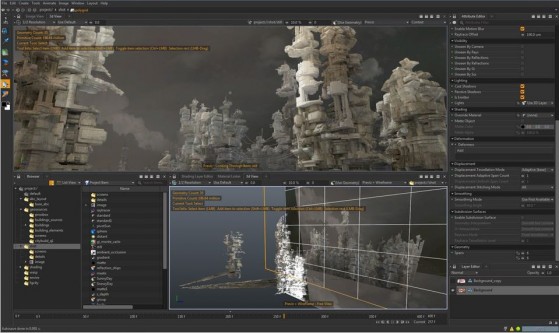The high-end 3D/3D tool fuses animation with compositing and 3D rendering, allowing artists to work with full effects on all the time.
Every year at Siggraph there are one or two products that cause people to say to one another, “Have you see ____?” This year in Vancouver one of those products was Clarisse iFX 2.0, a new high-end 2D/3D CG arts product. The result of years of development time, Clarisse iFX is the product of French start-up Isotropix. The software is designed to allow artists to work directly on final images, making it possible to see what the final design will look like at all stages of production.

Working in full rendered view all the time requires powerful hardware, so it is a bit surprising that Clarisse iFX renders on CPUs, not the potentially more powerful GPUs. There is still considerable support in the industry for CPU-based rendering, with its ability to be more agile with vector instructions, loops, and conditions. The rendering engine in Clarisse iFX is a homegrown global illumination Monte Carlo renderer, not a physically based shader. To keep things fast it uses layering to organize how and when elements of the art get re-rendered.
Technically Clarisse iFX 2.0 is in private beta, but at Siggraph Isotropix announced that visual effects studio Double Negative has purchased a global site license of Clarisse iFX. The studio said it would use Clarisse iFX as its main look development, lighting, and rendering application in London, Singapore, and Vancouver offices. Double Negative managing director Alex Hope said his company wanted to work with a company in close partnership to order to influence future development. It used early versions of Clarisse on Godzilla and Exodus.

The software runs on 64-bit Linux with a minimum of 2 GB RAM; more RAM improves performance. When the next version is released it will also run on Windows and Mac OS X. An OpenGL 2.0 compliant graphics card is required. Right now the software is CPU based, but “we never closed any doors to GPU in the future,” says Isotropix CEO Sam Assadian.
What do we think?
Working in realistic view is the Holy Grail of all computer-based design. An engineer or matte artist both want to think about the product as it will look when created, not as a geometric abstract. Others are working to provide the M&E industry stalwarts such as Maya and 3ds Max with real-time rendering through plug-ins. Clarisse prefers to take the approach of building a better tool from scratch—and there will always be a market for products that take on incumbents with new technology and new approaches.





